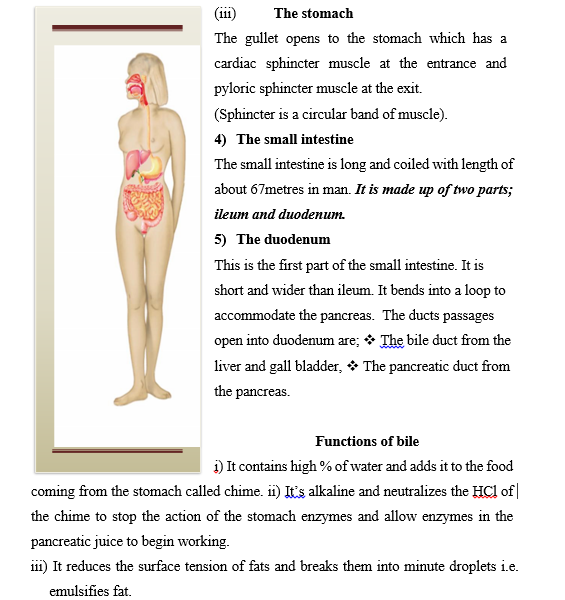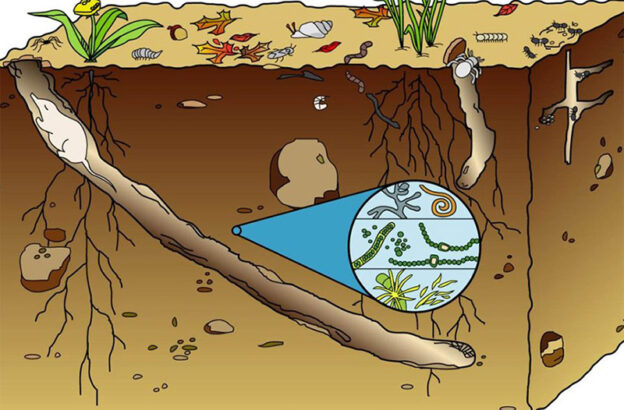LESSON 6
6.1 Parts of the alimentary canal
- The mouth
The mouth has the teeth and salivary glands. The mouth opens to the large space called buccal cavity. The mouth is roofed by the plate of bone called hard plate which is continuous with the soft palate (pharynx).
Once food is in the buccal cavity, the teeth break down food particles into smaller particles providing a large surface area for the enzyme action. On the floor of the cavity is the long muscular organ, the tongue which is covered by the taste buds. The tongue moves food around the mouth for chewing to occur and mixing with saliva secreted by salivary glands. Saliva contains enzymes and mucus which moistens, softens and lubricates food as well as sticking food particles together into boluses for easy swallowing. The enzyme in the saliva is called salivary amylase (ptyalin).
- Oesophagus
This is a straight tube that passes from the mouth through the thorax and diaphragm into the abdomen.
When the food is fully chewed, the tongue rolls it into bolus pushes it against the soft palate at the back of the mouth (pharynx). This initiates the process of swallowing the food into the oesophagus. The tube adjacent to the oesophagus is the trachea which leads to the lungs. During swallowing, the flap of the tissue called epiglottis above the trachea prevents food from entering into the trachea.

- The ileum
This is the second part of small intestines. It is long and coiled with length of about 6-7metres in man. It involves digestion and absorption.
Its lining has numerous tiny finger-like structures called villi (singular; villus) which increase surface area for absorption.
- The large intestines
In man it consists of colon, appendix and rectum which open at the anus.
Note: in rabbits, the large intestine consists of the caecum which is very large and ends in the blind appendix and small colon leading to the rectum.
6.2 DIGESTION IN THE MOUTH
Digestion in the mouth is both physical and chemical. a) Physical digestion
Physical digestion in the mouth is carried out by the action of teeth or is the act of Mastication / chewing.
6.3 Mastication is important in that;
- Increase the surface area of food for efficient Enzyme action.
- It helps to mix the food with saliva and in so doing; it softens the food, mixes it with the enzymes and lubricates it with the mucus in the saliva.
- With the help of the tongue , the food is rolled into a Bolus (a small ball) for easy swallowing and movement in the gut.(alimentary canal)
- Chewing stimulates enzyme secretion because the secretion of saliva is a reflex action stimulated by the presence of food in the mouth.
NOTE: The secretion of saliva can also be stimulated by sight, smell and sought of food.
b) Chemical digestion in the mouth.
Chemical digestion is carried out by the enzyme Salivary amylase
Saliva is an alkaline watery solution and it provides the optimal PH for the action of amylase i.e a high PH.
Salivary amylase acts only on cooked starch breaking it down to disaccharide called Maltose.

6.4 The act of swallowing:
Swallowing is a reflex action. Here, food is rolled into a Bolus which is then transferred into the Oesophagus (gullet).
During the act of swallowing, breathing momentarily stops and the epiglottis closes the Entrance into the trachea preventing food from entering into the trachea. At the same time, the soft palate also closes the entrance into the nose cavity preventing the food from escaping or passing through the nose.
Once the bolus is in the oesophagus, the food moves by a wave of muscular contractions called Peristalsis.

